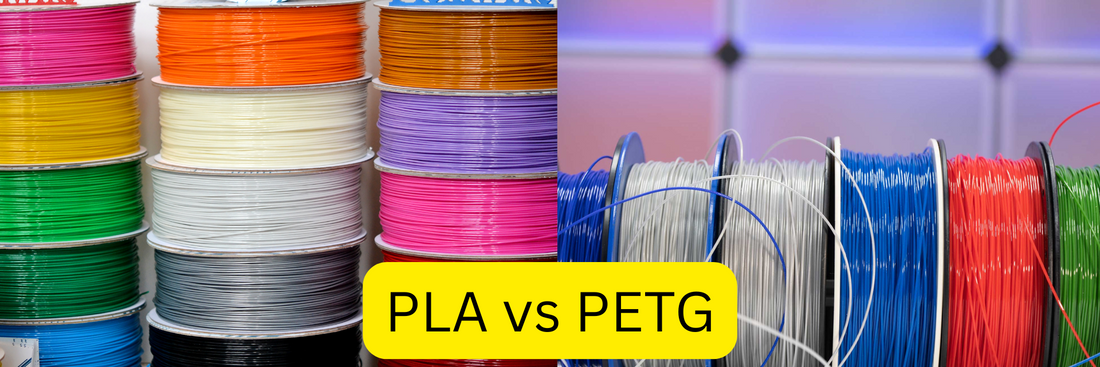Choosing the right filament is one of the most important decisions in 3D printing especially if you care about print quality, durability, and sustainability. Two of the most popular choices are PLA and PETG. Both offer unique benefits, but which one is the better fit for your project?
In this guide, we’ll break down the key differences between PLA vs PETG filament, including strength, printability, environmental impact, and real-world applications. Whether you're just getting started or optimizing prints for clients, this comparison will help you make an informed, future-proof choice.
- What is PLA? Benefits, Applications, and Its Role in Sustainable Packaging
- PBAT (Polybutylene Adipate Terephthalate): A Comprehensive Guide to the Biodegradable Polymer
What Is PLA Filament?

PLA (Polylactic Acid) is a bio-based thermoplastic made from renewable resources like corn starch or sugarcane. It is one of the easiest materials to print with, making it ideal for beginners, educators, and designers working on prototypes or decorative objects.
Key Features:
- Biodegradable in industrial composting facilities
- Prints at low temperatures (~190–220 °C)
- No heated bed required
- Smooth surface finish and vibrant color options
- Minimal warping and excellent detail resolution
Despite its green profile, PLA does have some limitations in strength and heat resistance, which is where PETG enters the conversation.
What Is PETG Filament?

PETG (Polyethylene Terephthalate Glycol-modified) is a strong, semi-flexible plastic derived from the same base material used in water bottles (PET), but enhanced with glycol for improved durability and printability. PETG bridges the gap between PLA's ease of use and ABS's strength, making it a favorite for functional parts and outdoor use.
Key Features:
- High impact resistance and durability
- Water-resistant and UV-resistant
- Prints at higher temperatures (~220–260 °C)
- Requires heated bed (60–80 °C)
- Food-safe (with the right certifications)
- Excellent layer adhesion
PLA vs PETG Filament – General Comparison
| Property | PLA | PETG |
|---|---|---|
| Source | Renewable (plants) | Petroleum-based (recyclable) |
| Print temperature | ~190–220 °C | ~220–260 °C |
| Heated bed required | No | Yes (~70 °C) |
| Print difficulty | Very easy | Moderate (stringing issues) |
| Strength | Medium (can be brittle) | High (flexible & durable) |
| Environmental impact | Biodegradable in some settings | Recyclable, longer lifespan |
| Ideal for | Prototypes, models, decor | Functional parts, outdoor items |
PLA vs PETG Strength – Which Is Stronger?

When it comes to tensile strength and impact resistance, PETG clearly outperforms PLA in most scenarios:
Tensile Strength
- PLA: ~57–65 MPa – rigid but brittle under stress
- PETG: ~50–56 MPa – slightly lower tensile strength but far more ductile
Impact Resistance
- PLA tends to snap under pressure
- PETG absorbs shock and bends without breaking
Durability in Use
PETG parts hold up better in mechanical environments and outdoor exposure, while PLA is more suitable for static objects or concept models.
PLA vs ABS vs PETG – How Do They Compare?
Aside from PLA and PETG, ABS (Acrylonitrile Butadiene Styrene) is another filament often considered for tougher, functional prints. Here’s how all three stack up:
| Feature | PLA | PETG | ABS |
|---|---|---|---|
| Printability | Very easy | Moderate | Difficult |
| Heat resistance | Low (~60 °C) | Medium (~75 °C) | High (~100 °C) |
| Strength | Moderate | High | High |
| Warping | Minimal | Low | High |
| Odor when printing | Almost none | Minimal | Strong (toxic) |
| Eco-friendliness | High (biodegradable) | Medium (recyclable) | Low |

Is PETG Waterproof?
Yes – PETG is known for its excellent water resistance, making it ideal for:
- Bottles and containers
- Outdoor fixtures
- Aquatic or humid environments
However, achieving fully watertight 3D prints depends on:
- Print settings (layer height, wall thickness, infill)
- Proper extrusion and adhesion
- Post-processing (e.g., smoothing or sealing)
Sustainability: PLA vs PETG
| Aspect | PLA | PETG |
|---|---|---|
| Source | Renewable (corn, sugarcane) | Petroleum-based |
| Compostability | Industrial compost only | Not compostable |
| Recyclability | Not widely recycled | Widely recyclable |
| Durability/longevity | Low to medium | High (less waste over time) |
| Emission (nano/microplastics) | Lower under normal use | Even lower with enclosed printers |
Use Cases for PLA and PETG
PLA Is Best For:
- Prototypes and demo models
- Decorative prints and toys
- Educational projects
- Biodegradable or short-term items
PETG Is Best For:
- Functional, load-bearing parts
- Electronics enclosures
- Water-resistant containers
- Outdoor equipment
- Reusable products
Choosing the Best Compostable Bags – A Practical Guide for Eco-Conscious Users
Real-World 3D Printing Experience
PLA
- Easy to work with, minimal calibration
- Beautiful surface finish
- Prints fast, low failure rate
PETG
- More sensitive to settings (stringing, oozing)
- Benefits from slower print speeds and reduced cooling
- Use higher wall count and lower retraction for best strength
Cost Comparison & Long-Term Value
| Factor | PLA | PETG |
|---|---|---|
| Price | ~$15–20/kg | ~$20–30/kg |
| Print failures | Fewer | Slightly more |
| Durability | Lower | Higher |
| Value over time | Good for beginners | Excellent for advanced prints |
Although PLA is cheaper, PETG offers better performance per gram, especially for parts that must last.
Is PLA or PETG Better? Final Verdict

It depends on your goals:
| If you want... | Choose... |
|---|---|
| Easy printing with minimal tuning | PLA |
| Eco-conscious filament (biodegradable) | PLA |
| High strength & impact resistance | PETG |
| Outdoor or water-resistant parts | PETG |
| Recyclable material with long lifespan | PETG |
For most users, PETG offers a better balance between strength, sustainability, and usability especially when properly configured.
FAQs
Is PLA biodegradable at home?
No. PLA requires industrial composting conditions to break down effectively. It won’t decompose in your backyard.
Is PETG food-safe?
PETG is generally considered food-safe, but always check manufacturer certifications. Post-processing (like sanding) can affect safety.
Can PETG be used outdoors?
Yes. PETG is UV- and weather-resistant, making it suitable for outdoor applications.
How to reduce stringing with PETG?
- Increase retraction distance
- Lower print temperature slightly
- Use slower print speeds
- Enable coasting in slicer settings
Conclusion
PLA is the go-to filament for simple, beautiful, and eco-friendly prints, while PETG is ideal for users who need tough, weatherproof, and reliable parts. Offering both materials allows you to cater to a wide range of customer needs, especially those looking for sustainable packaging and printing solutions.




